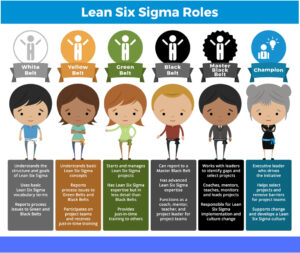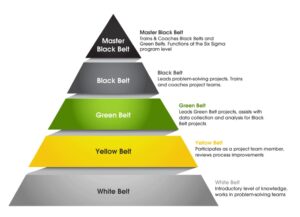isixsigma.com

The Science Behind Box Plot Whiskers
Updated:Overview: What is a whisker? We need to do a quick review of a box plot before discussing a whisker. The box plot, also referred to as a box and whiskers plot, was introduced in 1970 by American statistician, Dr. John Tukey. A box plot consists of two parts, a box, and a set of […]
Read more »
Continuous vs. Attribute Data: What’s the Difference?
Published:What is Continuous? Continuous data refers to numerical data that has any value within a certain range. There are infinite possibilities for the values, but they all fall within a range. These can be whole numbers or decimals measured using data analysis like skews and line graphs. This kind of data can change over time […]
Read more »
Null vs. Alternative Hypothesis: What’s the Difference?
Published:What is Null Hypothesis? Statistical information without context or contrast is meaningless. Anyone looking at a data set can find connections and discover patterns, but they’ll probably end up drawing all kinds of wrong conclusions. That’s why statisticians have to examine the data from two different perspectives and always consider how the information they are […]
Read more »
Categorical vs. Continuous Data: What’s the Difference?
Published:What is Categorical Data? Categorical data is statistical information that is presented according to its division into certain groups. In this model, values are sorted into predefined categories according to the design of the analysts. Grouping data points into categories in this way can be useful depending on the goals of the research, but it’s […]
Read more »
Discrete vs. Continuous Data: What’s the Difference?
Published:Discrete vs. Continuous Data: What’s the Difference? When it comes to Six Sigma, data is your lifeblood. The ability to interpret what the data is saying is how you know whether you are on the right path in achieving your goals and objectives and avoiding roadblocks on your journey towards success. Accurately collected and analyzed […]
Read more »
The Impact of Lurking Variables: Why Ignoring Them Can be Costly
Updated:You just did some statistical analysis, but your results don’t make sense to you. Did you capture all the variables you needed or is there something you missed? Maybe there is a lurking variable.
Read more »
The Role of X Bar in Statistics: An Overview
Updated:There are three measures of central tendency for data. One is the mean or x-bar, the others are the median and mode. Let’s take a closer look at the mean or x-bar. Overview: What is x-bar? In statistics, the Latin small letter x is used to represent a variable in a set of sample data. […]
Read more »
Understanding Range: What it is and What it isn’t
Updated:The three descriptors that can be used to describe the variation or dispersion of your data are the standard deviation, variance and range. The range is the easiest to calculate, but not the most useful in describing the variation of your data.
Read more »
Expert Tips and Tricks for Using Pareto Charts in Your Data Analysis
Updated:You have probably heard of the Pareto Principle and used a Pareto Chart. Since it is one of the 7 QC Tools, let’s explore this topic in a little more detail.
Read more »
Breaking Down What You Need to Know About Main Effects
Updated:If you wanted to improve the gas mileage of your car, what factors would you look at to do that? How would you measure the impact or effect of those factors? Computing the main effect could answer your question.
Read more »
What is the Median and Why is it Important in Statistics?
Updated:The median strip in the road runs down the middle so half the road is on one side and the other half on the other side. Does the statistical median do the same thing?
Read more »
Bimodal Distributions and Why They Matter
Updated:One of the important statistical descriptors of your data is its central tendency. Central tendency can be described using the mean, median and mode of the data. The mean is described as the mathematical center of your data. The median is the physical center of your data, and the mode is the most frequently occurring value in your data.
Read more »
Flowchart vs. Process Map: What’s the Difference?
Published:What is a Flowchart? A flowchart is a diagram of several boxes or other shapes connected with arrows, wherein each box is text that represents a step in a process or workflow. It is meant to reflect the process or workflow step-by-step, in sequential order, with multiple boxes having various arrows off-shooting from them, connecting […]
Read more »
Voice Of The Process vs. Voice Of The Customer: What’s the Difference?
Updated:What is the Voice Of The Process? Voice Of The Process (VOP) is the manner in which a process communicates its performance capability to meet the expectations, wants, and needs of the customer. The Benefits of the Voice Of The Process Through analysis of your VOP, you gain insight into what moves you need to […]
Read more »
Customer Journey Map vs. Process Map: What’s the Difference?
Updated:What is a Customer Journey Map? A customer journey map is a diagram that visually represents the various steps a customer goes through in engagement with your company. This can be with a product, service, online and in-person interaction, or a combination. The Benefits of a Customer Journey Map A customer journey map has a […]
Read more »
Critical To Quality vs. Critical to Customer: What’s the Difference?
Published:What is Critical To Quality? Critical to quality refers to the things necessary for a company to have in place in order to meet the needs of the customer. It is the attribute of a process or service that has a direct impact on its real or perceived quality. The Benefits of Critical To Quality […]
Read more »
Value Stream Map vs. Process Map: What’s the Difference?
Published:What is a Value Stream Map? A value stream map is a visual representation of all the components that are needed to deliver a product/service. It looks at the components individually and as a whole, with the goal of eliminating waste and optimizing the entire process. The Benefits of a Value Stream Map A value […]
Read more »
Lead Time vs. Takt Time: Which One Should You Prioritize?
Updated:What is Lead Time? Lead time is the amount of time that it takes to get a product or service completed for a customer, from the time of ordering until completion of delivery. A lot of factors can figure into the amount of lead time. Some factors include supplier back-up, other orders that need fulfilling, […]
Read more »
PDCA vs. OODA: What’s the Difference?
Published:What is PDCA? The Plan-Do-Check-Act (PDCA) method is a framework used to achieve continuous improvement in a particular organization or process. It’s also known by several other names, including the Deming wheel, Shewhart cycle and the control circle. Even though the method was originally rooted in quality control, it has since been adapted and adopted […]
Read more »
Lean Six Sigma Certification Levels
Published:Dr. Mikel Harry is often credited with adapting the martial art concept of belt rankings to Lean Six Sigma (LSS). The hierarchy of belts indicates the level of training, competency, and acquisition of skills. While different organizations may have different names and colors for the levels of expertise in LSS, the following represents the most […]
Read more »
PDSA vs. PDCA: What’s the Difference?
Published:What is PDSA? PDSA stands for Plan, Do, Study, and Act. It is a method that is used in order to test a change that is being implemented or has been implemented. Working through these four steps guides thinking into breaking down a task into sections and then evaluating the result, making improvements, and then […]
Read more »
Cycle Time vs. Throughput Time: What’s the Difference?
Published:What is Cycle Time? Cycle time can be defined as the amount of actual work time needed to complete one task. Any sort of downtime is excluded from cycle time. The Benefits of Cycle Time Staying ahead of the competition – You can outpace your competition by keeping a close eye on your cycle time […]
Read more »
Flow Time vs. Cycle Time: What’s the Difference?
Published:What is Flow Time? Flow time describes the full interval between the beginning and end of a particular process. The most common context is manufacturing where flow time would begin with the first stage of the assembly line and conclude with packaging or transit. However, the term can be used in any business context to […]
Read more »
Lean Six Sigma Champion Training and Certification
Published:The rock band, Queen, celebrated Champions with these lyrics; “We are the champions…. my friends….And we’ll keep on fighting ’til the end….We are the champions….We are the champions….No time for losers….’Cause we are the champions….Of the world.” Lean Six Sigma also has its Champions. Let’s learn more about them. Role of the Champion While Lean […]
Read more »
The Effects of Buffering on the Production Cycle
Updated:Buffers are basic protection for businesses, but going too big can be a major source of waste.
Read more »
Process Time vs. Cycle Time: What’s the Difference?
Updated:What is Process Time? Process time describes the interval required for a product or service to progress through a specific development stage. The exact scope of a “development stage” depends on the context. In industry or manufacturing, each stage is usually confined to a particular physical location with a workstation and equipment. Understanding and improving […]
Read more »
Lean Six Sigma Master Black Belt training and certification
Published:Does the term Master Black Belt sound pretty impressive? It should, because it is the highest level of achievement and expertise in Lean Six Sigma. Let’s explore the role of a Lean Six Sigma Master Black Belt and how you can attain that pinnacle of success. Role of the Master Black Belt As you can […]
Read more »
Lean Six Sigma Black Belt Training and Certification
Published:Will having a Lean Six Sigma Black Belt allow you to break bricks and beat up other people? Probably not, but it will help you remove waste, analyze data and improve processes in your organization. Let’s see what a Lean Six Sigma Black Belt does and how you can become one. Role of the Black […]
Read more »
Lean Six Sigma Green Belt Training and Certification
Published:Lean Six Sigma Green Belt is where your more advanced training and certification begins. If you are already a White or Yellow Belt, you have learned some of the basic concepts of Lean Six Sigma. Green Belt is where your learning really takes off. Role of the Green Belt The hierarchy of Lean Six Sigma […]
Read more »
PDCA vs. DMAIC: What’s the Difference?
Published:What is PDCA? Plan Do Check Act (PDCA) is a cyclical method for achieving continual improvement of an organization or process. In the first stage, companies must clearly identify and define a specific problem. The “Do” step is about taking a small, controlled action with a limited release, pilot project or other sampling technique. Stage […]
Read more »
Lean Six Sigma White Belt Training and Certification
Published:You are ready to start your Lean Six Sigma journey but where do you start? White Belt training and certification is the entry point into learning about Lean Six Sigma. Lean Six Sigma White Belt training and certification If your organization is deploying a Lean Six Sigma (LSS) initiative, and you can participate in White […]
Read more »
Lean Six Sigma Training and Certification
Published:Organizations have been deploying and implementing Lean Six Sigma for decades. Yet, there are still many questions on how someone can get formally trained and certified in the tools, methodologies and philosophy of Lean Six Sigma. This article will be the first in a series to answer some of the most common questions about Lean […]
Read more »
Lean Six Sigma Yellow Belt training and certification
Published:After completing your training and certification for White Belt, your next step might be to advance to Yellow Belt training and certification. Let’s see what’s involved with that. Lean Six Sigma Yellow Belt training and certification As a Lean Six Sigma (LSS) Yellow Belt (YB), you will gain some basic knowledge and learn some skills […]
Read more »
Takt Time vs. Cycle Time: What’s the Difference?
Published:What is Takt Time? Takt Time refers to the speed at which a product must be manufactured in order to meet customer demand. The Benefits of Takt Time Implementing Takt Time into your organization is beneficial for a number of reasons: Identifying bottlenecks – If an organization is making Takt Time a priority, bottlenecks tend […]
Read more »
Lead Time vs. Cycle Time: What’s the Difference?
Updated:What is Lead Time? Lead time is the duration or latency between when a process is initiated and when it is completed. One example would be if a book is ordered by a publisher to be written and its estimated time until delivery is six months, then six months is the lead time. The Benefits […]
Read more »
How D-MAGICS is Improving the DMAIC Framework
Updated:D-MAGICS is a sub-methodology within Lean Six Sigma for improving processes. It aims to make the DMAIC tool easier to successfully execute by emphasizing the importance of grasping the existence of the problems and realistically sustaining the corrections.
Read more »
What is the Best Lean Six Sigma Training and Certification?
Published:Getting recommendations from others for your Lean Six Sigma training and certification is a good strategy. But given all the variation in available programs, it is a good idea to have a list of criteria to compare your recommendations. Here is a list to get you started. What is the best Lean Six Sigma training […]
Read more »
What is the Impact on my Compensation if I am Lean Six Sigma Trained and Certified?
Published:Taking Lean Six Sigma training and getting certified will cost you time and money. Is it worth it? Will you earn more money with the additional credential of a Lean Six Sigma belt? Let’s check it out.
Read more »
What is the Cost of Lean Six Sigma Training and Certification?
Published:If you are being Lean Six Sigma trained and certified by your employer, the cost should not be a concern for you. But what if you must pay for it by yourself? Cost may then be important. Let’s explore the variation in cost for being LSS trained and certified.
Read more »
Lean Six Sigma Training and Certification: Online or in Person?
Updated:Do you like to take classes in a physical classroom or virtually on a computer? This is a significant decision since Lean Six Sigma training and certification can be achieved either way. Let’s examine the plus and minus of each format.
Read more »
Why is Lean Six Sigma Accredited Training and Certification Important?
Published:Would you be happy if your doctor received her MD from an unknown and unaccredited medical school? Probably not. What about your CPA or attorney? Again, probably not. For the same reason, your employer wouldn’t be happy with your Lean Six Sigma certification if it was awarded by an unknown organization with a poor reputation […]
Read more »
What is Lean Six Sigma Training and Certification?
Published:There are two steps to earn a martial arts belt. First, you must be trained in the various techniques and then you must demonstrate your skills and knowledge. The same holds true for Lean Six Sigma training and certification. Let’s learn a little more. What is Lean Six Sigma training and certification? In martial arts, […]
Read more »
The Importance of Mid Rank for Test Extensions and Ties
Updated:If you have an ordered list and the numbers need to be ranked, having ties can make things difficult. Thankfully, there is a simple solution for addressing this.
Read more »
Five Ways Throughput Improves Your Business
Updated:In business, it is important to know if your company is reaching its potential as far as how much of your product or service is successfully getting to your customers. One way is to look at your throughput and see if there is room for improvement.
Read more »
Understanding the Variables Involved in Team Capacity Planning
Updated:It is crucial to know that you have the appropriate resources available to meet the needs of a project. It is also important to know when you need to turn a project down or if you can adequately increase your resources in order to approve a new opportunity. Knowing the capacity of your team can help.
Read more »
Productivity Metrics: What to Measure and Why
Updated:Productivity is a measurement of business efficiency that compares the ratio of output with input.
Read more »
How Project Nominations Can Improve Employee Morale and Business Opportunities
Updated:Getting a project nominated for recognition is a massive accomplishment for a Six Sigma-adhering project. Having an understanding of the nomination process is necessary to get it to that point.
Read more »
Documenting Approvals: The Necessity of Process Acceptance Certificates
Updated:Beginning a new process may require approval. This may also be necessary whenever there is a change desired to an existing process. Retaining documentation of this approval is important for everyone involved in the process, including the owner, contractor, and any employees.
Read more »
The Advantages of a First In, First Out Inventory System
Updated:FIFO is an acronym for “first in, first out.” It functions to ensure a steady material flow, which is essential in any lean manufacturing process. Find out more about it.
Read more »
The Benefits of Lean Management: Prioritizing Critical Business Requirements
Updated:Some processes are more important than others. CBRs are the ones you simply can’t do without.
Read more »